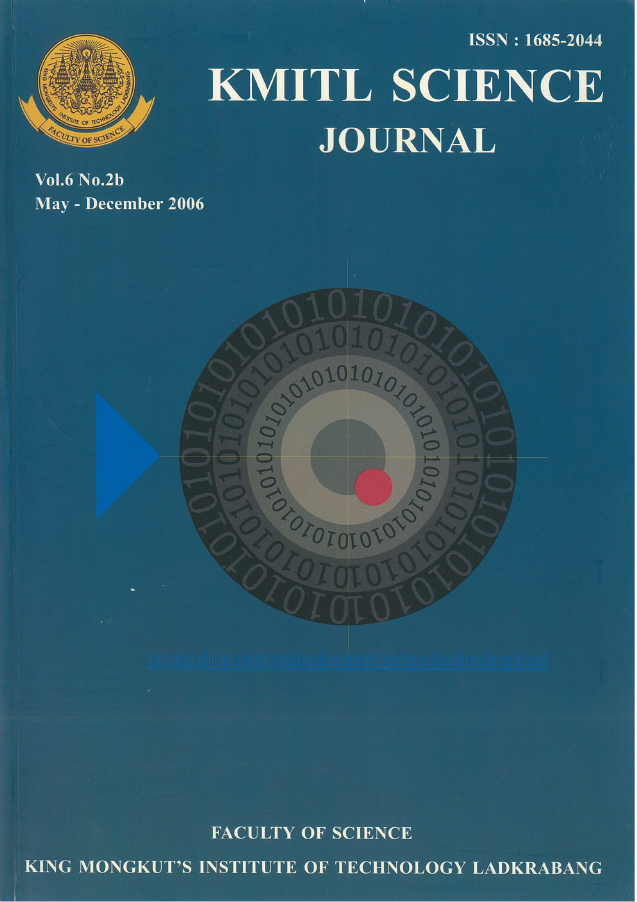Cracking of Mixed C4s to Propylene and Ethylene over Modified ZSM-5 Catalysts
Main Article Content
Abstract
Catalytic cracking of mixed C4s to propylene and ethylene was investigated over ZSM-5 with different acidity, crystallite size, modification technique and various feed composition in a continuous fixed-bed reactor. It was found that the acidity of zeolites plays important role in the catalytic activity and stability. In high acidity ZSM-5 catalysts, the high activity but low stability were obtained. Deactivation is ascribed to a consecutive reaction of hydrogen transfer and oligomerization. While, the ZSM-5 with low acidity exhibits good stability. Moreover, the crystallite size of zeolite was markedly influenced the stability of catalysts. The high stability of zeolite could be gained on smaller (< 0.5 micrometer) crystallite size. Modification of ZSM-5 possessed low Si/Al ratio by alkaline and alkaline earth ion exchange was remarkable decreased the conversion of mixed C4s. While, platinum impregnated provide a higher activity, as compared to the parent ZSM-5. In the reaction using olefin-rich as feed, it was found a higher conversion over acid catalyst, as compared to that of higher paraffinic hydrocarbons. Moreover, the suppression of hydrogen transfer by reduction acid site and reaction temperature, can enhance the ethylene and propylene selectivity. After the catalyst was regenerated by air, it was found that the higher activity was obtained, as compared to the fresh one, owing to the formation of Lewis acid site.
Keywords: Catalytic cracking, ZSM-5 catalyst, C4 Hydrocarbons
Corresponding author: E-mail: kstawan@kmitl.ac.th
Article Details
Copyright Transfer Statement
The copyright of this article is transferred to Current Applied Science and Technology journal with effect if and when the article is accepted for publication. The copyright transfer covers the exclusive right to reproduce and distribute the article, including reprints, translations, photographic reproductions, electronic form (offline, online) or any other reproductions of similar nature.
The author warrants that this contribution is original and that he/she has full power to make this grant. The author signs for and accepts responsibility for releasing this material on behalf of any and all co-authors.
Here is the link for download: Copyright transfer form.pdf
References
[2] Li, Y.L., 2001 Petro Petrochem. Today (Chin.), 9(4). 31.
[3] Stiffens, T.R., and Ladwig, P.K., US Patent 6,455,750 (2002) (to Exxon Mobil Chemical Patents Incorporation).
[4] Dath, J.P., and Vermeiren, J.W., WO 00/78894 (2000) (to Fina Oil & Chemical Corporation).
[5] Johnson, L.D., Nariman, E.K., and Ware, A.R., US Patent 6,222,087 (2001) (to Mobil Oil Corporation).
[6] George, A.O., 1995 Hydrocarbon Chemistry. New York, John Wiley & Sons.
[7] Sami, M., and Lewis, F.H., 1994 Chemistry of Petrochemical Processes. Houston, Gulf Publishing Company.
[8] Subhash, B. 1989 Zeolite Catalysis: Principles and Applications. Boca Raton, CRC Press, Inc.
[9] Takayuki, K., Hisaya, I., Yukino, F., and Tatsuaki, Y., 2001. Selective formation of alkenes through the cracking of n-heptane on Ca2+-exchanged ferrierite, Applied Catalysis A: General, 214, 103-109.
[10] Bruce, C.G., 1992 Catalytic Chemistry. New York, John Wiley & Sons.


